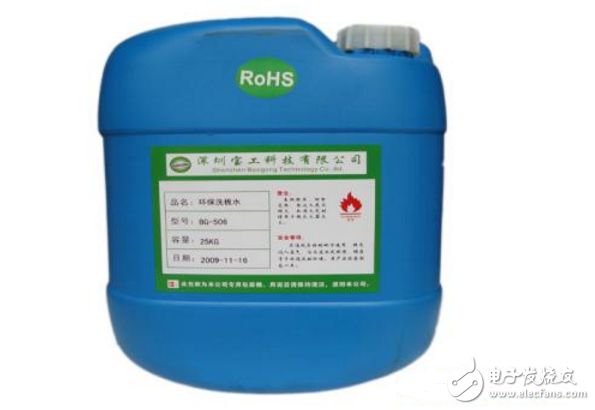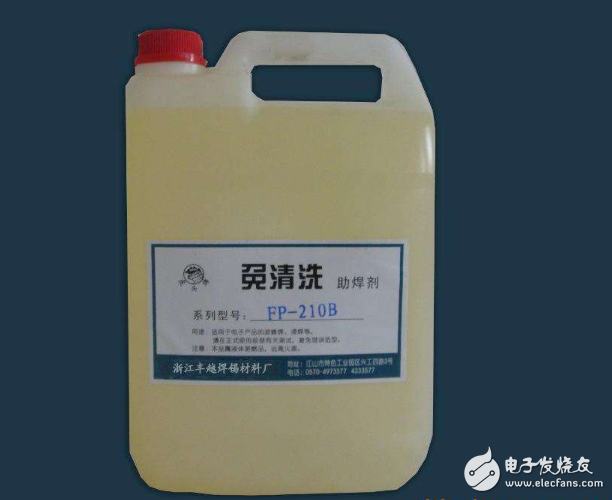Is cleaning-free flux easy to use _ how to use cleaning-free flux
Date:2019-10-18 Auto:
With the rapid development of electronic industry and fierce competition in the market, solder manufacturers all hope to produce products with excellent welding performance and low price. As an auxiliary material of solder paste (mass fraction is 10%~20%), flux can not only provide excellent soldering performance, but also directly affect the printing performance and storage life of solder paste.
Cleaning-free flux is a new type of flux that does not contain halide activator and does not need cleaning after welding. Using this kind of flux can not only save the investment in cleaning equipment and cleaning solvent, but also reduce the pollution to the environment caused by the emission of waste gas and waste water. Therefore, replacing traditional flux with non-cleaning flux has important economic and social benefits. For this reason, many researchers at home and abroad have carried out the development of no-clean flux products. In the early 1990s, China's clean-free flux was mainly imported, such as Alpha grillo RF-12A flux from the United States and NC316 flux from Japan.
In recent years, China has also seen some cleaning-free flux products. Clean-free flux shall meet the following requirements
1)The wetting rate or spreading area is large;
2)No residue after welding;
3)After welding, the board surface is dry and does not stick to the board surface.
4)Have high enough surface insulation resistance;
5)The chemical property is stable at normal temperature and there is no corrosion after welding.
6)Ion residue should meet the requirement of no cleaning.
7)Having on-line testing capability;
8)No solder balls or bridges are formed;
9)Non-toxic, no serious odor, no environmental pollution, safe operation;
lO)Good weldability and easy operation;
11)Can be evenly coated by foaming and spraying.

When soldering with solder containing solvent-cleaning flux and water-cleaning flux, environmental pollution will be brought to varying degrees. Especially, CF-C solvent will emit ODS, which has a great impact on the ozone layer. Therefore, all countries have enacted corresponding laws prohibiting its use. Non-cFC solvent has high cost, VOC pollution and safety problems. However, the investment in water cleaning equipment is large, the operation cost is increased due to one more step of cleaning process, and the wastewater discharge problem is also serious. Compared with solvent-cleaning flux and water-cleaning flux, solder containing no-cleaning flux has the advantages of no environmental pollution, low cost, short production period, simple process, etc. Cleaning-free flux will be the development trend of the industry.
Good weldability, full solder joints, no welding beads, bridging and other defects
Non-toxic, no environmental pollution, safe operation
After welding, the board surface is dry, non-corrosive and non-sticky.
On-line test capability after welding
It has corresponding material matching with SMD and PCB board.
After welding, there is a surface insulation resistance value (SIR) conforming to regulations.
Suitable for welding process (immersion welding, foaming, spraying, coating, etc.)
Low rosin type cleaning-free flux
Low rosin type cleaning-free flux is a flux specially used for machine welding of advanced multilayer circuit boards. This kind of flux has strong soldering ability, good foaming performance, no halogen, no corrosiveness to solder and bare copper due to smoke and its residue generated during soldering, and the best state is obtained at a higher preheating temperature of 100-130℃. Therefore, it is an ideal cleaning-free flux with extremely high surface insulation resistance and quick drying effect on the board, and the sticky feeling of the board can also be reduced to a minimum. It can easily pass the test procedure and is suitable for wave soldering, spray soldering and manual soldering of any high-grade circuit board. The solvent in the flux should not only protect the welding surface well, but also have appropriate viscosity. Alcohols with high boiling point have better protection effect, but they have high viscosity and are inconvenient to use. Alcohol with low boiling point has low viscosity but poor protection, so the method of mixing alcohol can be considered. Some data show that the mixed solvent with the ratio of ethanol, ethylene glycol, glycerol and ethylene glycol butyl ether (mass ratio) of 2: 8: 8: 1 has the best effect.
Rosin uses improved high stability rosin resin for electronics, and some additives dissolved in rosin to improve welding speed must be added during welding to remove darkened oxide layer on metal surface to strengthen welding ability. At present, the most suitable combination of organic amine and organic acid with strong wetting ability is used in this aspect. For example, Xue Shuman et al. introduced a halogen-free rosin-based low-solids no-cleaning flux in the special' Li' in which aliphatic diacid, aromatic acid or amino acid are used as active ingredients, lower aliphatic alcohol is used as solvent, hydrocarbon, alcohol and grease are used as film forming agents, and cosolvent is ether and grease.

Rosin-free cleaning-free flux
The flux is a halogen-free, rosin-free, synthetic resin and new active agent system. Rosin-free and halogen-free cleaning-free flux mainly consists of activator, solvent, film-forming substance and antioxidant heat stabilizer. The solvent is a mixture of high boiling point alcohol and low boiling point alcohol. The activator is a mixture of organic acid and organic amine. The film-forming material is a synthetic polymer resin material, which has good electrical properties, has no obvious activity as a protective film at normal temperature, and shows activity at a welding temperature of 200-300 deg C .. Silicon modified acrylic resin has the characteristics of no corrosion, moisture resistance and excellent three-proofing performance, and can be used as a film forming agent. In addition, antioxidant heat stabilizer hydroquinone and protective agent benzotriazole are selected as auxiliary components. For example, a low solid content cleaning-free flux with adipic acid, sebacic acid and benzotriazole as active ingredients, ethylene glycol monobutyl ether, ethanol and isobutanol as solvents, and Thomas amphoteric active agent, fluorocarbon ion surfactant and fast penetrant OT as special ingredients.
The selection of flux is a key to achieve the specified quality level without cleaning the PCB surface after soldering. Generally, the following requirements are required for the flux without cleaning:
Non-corrosive: Halogen-free, Surface Insulation Resistance "1.0×1011Ω. Due to its high solid content, traditional flux can" wrap up "some harmful substances after welding to isolate contact with air and form an insulation protection layer. However, no-clean flux cannot form an insulating protective layer due to extremely low solid content. If a small amount of harmful components remain on the board surface, it will lead to serious adverse consequences such as corrosion and leakage. Therefore, halogen components are not allowed in the cleaning-free flux.
Low solid content: below 2%, the traditional flux has high solid content (20-40%), medium solid content (10-15%) and low solid content (5-10%). PCB board surface soldered with these fluxes has more or less residue, while the solid content of no-clean flux is required to be less than 2%, and it cannot contain rosin, so there is basically no residue on the board surface after soldering.
Test method for corrosivity of flux:
Copper Mirror Corrosion Test: Test the Short-term Corrosion of Flux (Solder Paste)
Corrosive Test: Test the corrosivity of residues on PCB surface after soldering.
Silver Chromate Test Paper Test: Test the Halide Content in Flux
Test the degree of conductor spacing reduction on PCB surface after soldering.
Surface insulation resistance test: test the surface insulation resistance of PCB after soldering to determine the reliability of long-term electrical performance of flux (solder paste)
1.Check whether the specific gravity of flux is the normal specific gravity specified by this product.
2.During the use of flux, if it is found that the consumption of diluent increases suddenly and the specific gravity continues to rise, it may be that other impurities with high specific gravity are mixed in, such as water, oil and other chemicals. The reason should be found out and all flux should be replaced.
3.The flux level should be kept at least about one inch above the foaming stone. The adjustment of foaming height should be about 1cm above the edge of foaming mouth.
4.When foaming is used, please regularly check the air pressure of the air compressor. It is better to prepare more than two water filters and use dry, oil-free and water-free clean compressed air so as not to affect the structure and performance of flux.
5.Adjust the angle of the air knife and the pressure and flow rate of the air knife. The spraying angle should be 10-15 degrees with the PCB traveling direction. If the angle is too large, the flux will be blown onto the preheater. If the angle is too small, the foaming will be blown away, resulting in poor soldering points.
6.If a brush is used, attention should be paid to whether the brush is in contact with the lower part. It is not good if it is too high or too low. It is better to keep it in light contact.
7.When foaming or spraying operation is used, the operation speed shall be determined according to the oxidation degree of PCB or part pin leads.
8.The operation speed shall be determined after the tin solution and PCB conditions are detected. It is recommended that the operation speed should be maintained at 3-5 seconds. If the welding is still not good after 6 seconds, it may need to be adjusted due to its substrate or operation conditions, and it is best to seek the assistance of relevant manufacturers to solve the problem.
9.Attention must be paid to the adjustment of the nozzle when spraying, and flux must be evenly distributed on the PCB surface.
10.Tin wave is flat, PCB is not deformed, and more uniform surface effect can be obtained.
11.Tin-coated PCB parts and solder surfaces must be dry and free of liquid residues.
12.When PCB oxidation is serious, please carry out appropriate pretreatment to ensure quality and solderability.
13.Preheating equipment on soldering machine shall keep PCB preheated at 80℃-120℃ before soldering